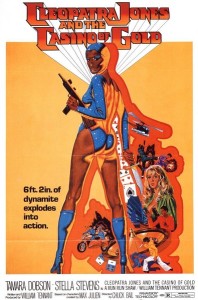Cleopatra Jones and the Casino of Gold
女金刚斗狂龙女
Hong Kong/US, 1975, colour, 2.35:1, 98 mins.
Director: Chuck Bail.
Rating: 5/10.
Blaxploitation meets Asian action in this formulary romp through Hong Kong and Macau.
Hong Kong, the present day. While investigating a drug-trafficking ring, two US government agents, Matthew and Melvin Johnson (Albert Popwell, Caro Kenyatta), are captured by gang leader Bianca Javin, aka Dragon Lady (Stella Stevens). Soon afterwards, US agent Cleopatra Jones (Tamara Dobson) arrives to investigate, reluctantly accepting the help of a local private detective, Feng Miling (Tian Ni), who helps her out while looking for Chen Suda (Zhan Sen), one of Dragon Lady’s associates. Cleopatra Jones and Feng Miling visit Dragon Lady’s casino in Macau, where one of her “adopted daughters”, Madalyna (Lin Zhenqi), is killed while trying to give them information. Cleopatra Jones and Feng Miling decide to  raid the casino, with the help of the latter’s squad of young motorcyclists.
raid the casino, with the help of the latter’s squad of young motorcyclists.
REVIEW
The temptation of setting a sequel to Cleopatra Jones (1973) in Hong Kong, and pitting six-foot-two of model Tamara Dobson against hordes of diminutive Chinese, was obviously too good to miss; apart from that running joke, however, this latest Warner-Shaws co-production (shot in 1974 and [in the UK] only now [Mar 1976] sneaked straight out on circuit release) is noteworthy for other curio aspects. Black Belt Jones (1974) and Enter the Dragon 龙争虎斗 (1973) have already shown black film culture mingling with eastern action pics; in Cleopatra Jones and the Casino of Gold 女金刚斗狂龙女 the two meet head-on, in a tripartite racial melange which for undiluted hybrid nerve compares favourably with Shaws’ regular exploitation films. The leads are almost exclusively western (with only Shaws star Tian Ni 恬妮 given much of a look-in), the cinematographer is British, the sets and rest of the cast are Chinese, and the filmic techniques West-Coast American.
The story is of the instantly disposable kind which leaves the viewer free to concentrate on details: Cleopatra Jones arrives in Hong Kong to extricate two narcotics agents from the hands of the Macau gambling queen, Dragon Lady, and several hundred dead Chinese later she leaves with her mission duly accomplished. [US] director Chuck [Charles] Bail dutifully takes her (and us) on guided tours of the city whenever she leaves the hotel, and the relentlessly formulary plot fits in plenty of bike/car/human chase sequences between routine bouts of martial arts. As always when East meets West, Americans are mostly characterised by gunplay and brute strength, Chinese by non-explosive weaponry and sheer agility. The former, as might be expected for the American market, is, unhappily, the more glamourised, and the script, after humouring the Chinese martial arts for about an hour, eventually loses its patience and descends into a welter of machine-guns and straight fist-fights for the climax. Director Bail, who starts the film encouragingly but falls into a gentle doze during the middle section, at least shows a measure of wit and pace during the final reels. Of any climactic bout between Dobson and Stella Stevens, we are unfairly robbed, despite the fact that the plot has kept the two of them simmering apart for over an hour. Their final meeting, a tatty knock-down-drag-out affair mostly in discreet shadow with doubles, provides no genuine climax, though perhaps the writing was on the wall after Stevens’ equally tacky combat sequence [earlier in the film] with Zhan Sen 詹森 (remember him as Dracula in The Legend of the 7 Golden Vampires 七金尸 [1974]?).
An enjoyable, then, but fractured romp, remarkable for its histrionics than anything else. Albert Popwell’s black narcotics agent is a nice cameo of the spaced-out variety (“Wow, man, this place is becoming a trip.” “Y’tell me.”), and along with Dobson he is given all the best lines. The latter, striding manfully through the picture in a succession of Arabian/African drag outfits (and in make-up credited to herself), gleefully ignores the titters of passers-by and gives the film its only consistent style. Stevens, either succumbing to the beauty of actress Lin Zhenqi 林珍奇 or trying to outdo Dobson in screen presence, is too muted to be a real villainess, though still looks good. The real star of the picture, when she is on-screen, is Tian, outclassing Dobson in both personality and grace – whether in blue jeans, bath-robe or spectacular white qipao. [She is also the main focus of the Hong Kong poster.]
[The film’s Chinese title literally means “Lady King Kong Fights Crazy Dragon Lady”.]
CREDITS
Produced by Shaw Brothers (HK)/Warner Brothers (US).
Script: William Tennant. Photography: Alan Hume. Editing: Willy Kemplen. Music: Dominic Frontiere. Song: Dominic Frontiere, Kenny Kerner, Richie Wise. Art direction: Cao Zhuangsheng [Johnson Tsao]. Costumes: Giorgio Di Sant’Angelo (for Tamara Dobson). Sound: Cyril Swern. Action: Eddy Donno (stunts), Tang Jia, Yuan Xiangren (martial arts). Special effects: Nobby Clark, Milt Rice.
Cast: Tamara Dobson (Cleopatra Jones), Stella Stevens (Bianca Javin/Dragon Lady), Tian Ni (Feng Miling), Norman Fell (Stanley Nagel), Albert Popwell (Matthew Johnson), Caro Kenyatta (Melvin Johnson), Zhan Sen (Chen Suda), Christopher Hunt (Mendez), Lin Zhenqi (Madalyna), Liu Luhua (Tony), Eddy Donno (Morgan), Bobby Canavarro (Chen Linma), Mei Guoxing (Benny), Zhang Wulang (David), Li Yunwu (Lao Di), Jin Biao (Han), Gigo Tevzadze (Qi Lun), Lok Sing (Mike), Chen Bao’er [Paul Chen] (man in Walled City), Victor Kahn (man in hallway).
Release: US, 11 Jul 1975; Hong Kong, 7 Nov 1975.
(Review section originally published in UK monthly films and filming, May 1976. Modern annotations in square brackets.)
